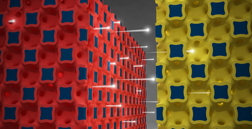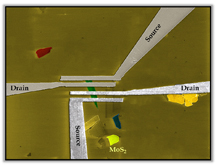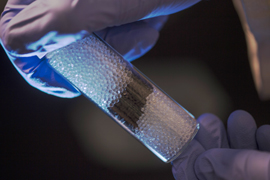Science
NASA’s Wind Mission Encounters ‘SLAMS’ Waves

Earth is surrounded by a giant magnetic bubble called the magnetosphere. As it travels through space, a complex system of charged particles from the sun and magnetic structures piles up in front of it. Scientists wish to better understand this area in front of the bow shock, known as the foreshock, as it can help explain how energy from the rest of space makes its way past this boundary into the magnetosphere.
- Read more
- 383 reads
How to Target an Asteroid

This spectacular image of comet Tempel 1 was taken 67 seconds after it obliterated Deep Impact's impactor spacecraft.
- Read more
- 343 reads
Small in size, big on power: New microbatteries a boost for electronics

The graphic illustrates a high power battery technology from the University of Illinois. Ions flow between three-dimensional micro-electrodes in a lithium ion battery.
- Read more
- 432 reads
From solar activity to stunning aurora

This beautiful aurora illuminates the sky over the snow-clad landscape near Tromsø, Norway.
- Read more
- 326 reads
Layered '2-D nanocrystals' promising new semiconductor

Researchers are developing a new type of semiconductor technology, pictured here, for future computers and electronics based on "two-dimensional nanocrystals." The material is layered in sheets less than a nanometer thick that could replace today's silicon transistors.
- Read more
- 349 reads
Chloroform cleanup: just the beginning for palladium-gold catalysts: Federally funded research pays off with new process for environmental remediation

When chloroform-contaminated water is flowed through a column containing PGClear pellets, the palladium and gold in the pellets spurs a chemical reaction that breaks down chloroform into nontoxic methane and chloride salt.
- Read more
- 399 reads
Where are the Best Windows Into Europa's Interior?

This graphic of Jupiter's moon Europa maps a relationship between the amount of energy deposited onto the moon from charged-particle bombardment and the chemical contents of ice deposits on the surface in five areas of the moon (labeled A through E).
- Read more
- 363 reads
U.S. Naval Research Laboratory Scientists “See” Flux Rope Formation for the First Time

Models of flux ropes have been drawn by theorists in the past, but scientists had never before observed them at the time they formed.
- Read more
- 396 reads
Blame it on the Rain (from Saturn's Rings)

This artist's concept illustrates how charged water particles flow into the Saturnian atmosphere from the planet's rings, causing a reduction in atmospheric brightness.
- Read more
- 381 reads
Human Rights
Fostering a More Humane World: The 28th Eurasian Economic Summi

Conscience, Hope, and Action: Keys to Global Peace and Sustainability

Ringing FOWPAL’s Peace Bell for the World:Nobel Peace Prize Laureates’ Visions and Actions

Protecting the World’s Cultural Diversity for a Sustainable Future

Puppet Show I International Friendship Day 2020


